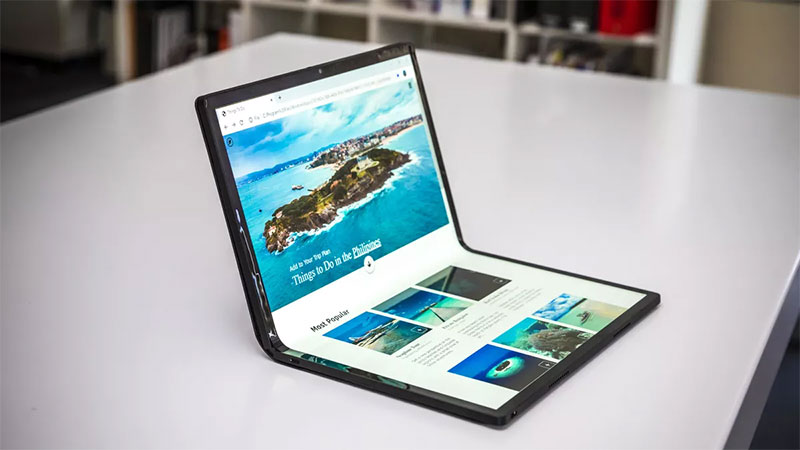Apple’s WWDC 2021: Focus and Control
8 June 2021

Foldable-screen laptops use display technology in an innovative way but have some way to go before finding significant traction.
Device users are always on the lookout for innovations from device vendors. But in an interesting twist, some of the latest products draw on our feelings of nostalgia. Are we hankering after the once-trendy flip phones or even old-fashioned hardback books? That appears to be the case with foldable-screen laptops at least. Laptops and smartphones can’t feasibly get much bigger than they are now, but vendors have shown that they can get more creative with how they manage screen real estate in new form factors.
The market for the foldable-screen form factor is booming. Canalys forecasts shipments of foldable-screen smartphones will grow by a CAGR of 53% between 2021 and 2024. Foldable displays in general are also expected to see phenomenal growth in coming years. People are gravitating toward bigger screens, which appears to be the major driving factor behind these devices. Canalys’ recent smartphone estimates reveal that the foldable-screen segment grew 148% year on year despite high price tags, while the overall smartphone market grew by only 7%.
When it comes to smartphones, which are typically our most heavily used devices, this shift in preference toward bigger and better screens via foldable displays makes sense. Moreover, foldable-screen phones combine the best of both worlds – tablets and smartphones. But we are not certain how far this will hold true for foldable-screen laptops. Are we looking at a future where laptops replace desktops or where they become all-in-one devices combining the best of tablet, laptop and desktop computing? From my perspective, though they are marketed as laptops, they appear to be an innovative take on the tablet form factor, offering better processing power and improved screen specifications in a compact and portable device.
People are constantly switching between different tasks and roles during their everyday work and leisure time, and with foldable-screen laptops they will not have to juggle between different gadgets to accomplish those activities. Be it reading, writing, working or even watching, these laptops feature a bendable display that allows us to use the device in multiple modes, offering versatility in the device’s operation.
Admittedly, there are few players in the market right now, but current devices have proven to be reliable. Lenovo and Asus each released their own versions of a foldable-screen laptop powered by Intel’s latest powerful processors and several foldable-screen concepts are in development, including Dell’s Ori and Samsung’s rumored patented foldable-screen laptop.
There are, however, a few concerns and unknowns that need to be addressed. To begin with, these devices do come with a learning curve, such as adjusting to an unconventional or on-screen keyboard, being mindful of the new screen hinge mechanism, getting accustomed to the new OS tailored for these devices, and becoming familiar with the multitasking features these devices have to offer. But will they be able to cater to users’ changing requirements in recent times, mainly CPU and GPU performance, and demands for greater battery life? Also, there are question marks around how well legacy software and operating systems will work with the different usage modes of these devices and even how seamless the transition between various modes will actually be.
The major concerns are with battery life and screen durability. Poor battery life remains one of the biggest complaints regarding these devices. It is an unsurprising challenge for vendors, given the improvements around the display specifications. And in terms of durability, the very innovation that makes this form factor compelling is what also places strain on its longevity. The crease of the screen fold is inevitably a weak point in the display with ongoing use. And even if there are a lot of emerging display component suppliers with competitive pricing, repairing these complex screens is likely to be an expensive hassle and something that channel partners will be wary of.
One positive is that while foldable-screen laptops are an emerging trend, they are not necessarily a brand-new concept for the PC giants. Intel’s Project Athena, in which the company co-engineers and invests in the design of future laptops along with the top PC OEMs, has taken foldable-screen laptops under its wing, building chips specifically designed for these devices. Microsoft, too, is working on its Windows 10X OS to seamlessly work on dual-screen PCs and foldable-screen laptops.
At present, foldable-screen laptops are high-end devices whose main selling factor is improved productivity and not necessarily improved battery life or performance. From this vantage point, it seems clear that foldable-screen laptops may not be commercially successful unless they fix these two drawbacks. Nevertheless, they offer a compelling case for consumers who are constantly on the move and workers who do not have to perform data-intensive tasks on a daily basis. The education sector could be one promising area for these devices, but the high costs are a significant impediment to success. Promoting foldable-screen laptops for gaming enthusiasts, who are a key target group for foldable-screen phones, is another impractical idea at this stage. Foldable-screen laptops may gain small levels of traction among gamers, but it is unclear how they’ll accommodate high-performance needs and cooling systems into an already space-constrained package.
Overall, foldable-screen laptops are still very much in the development phase and with so many unknowns, it’s difficult to get a sense of how successful they will be. With more competitors entering the market, the natural development of competitive specifications, pricing and screen durability holds some promise for devices in four or five iterations’ time, which was a similar trajectory for smartphones before perfecting foldable-screen designs.